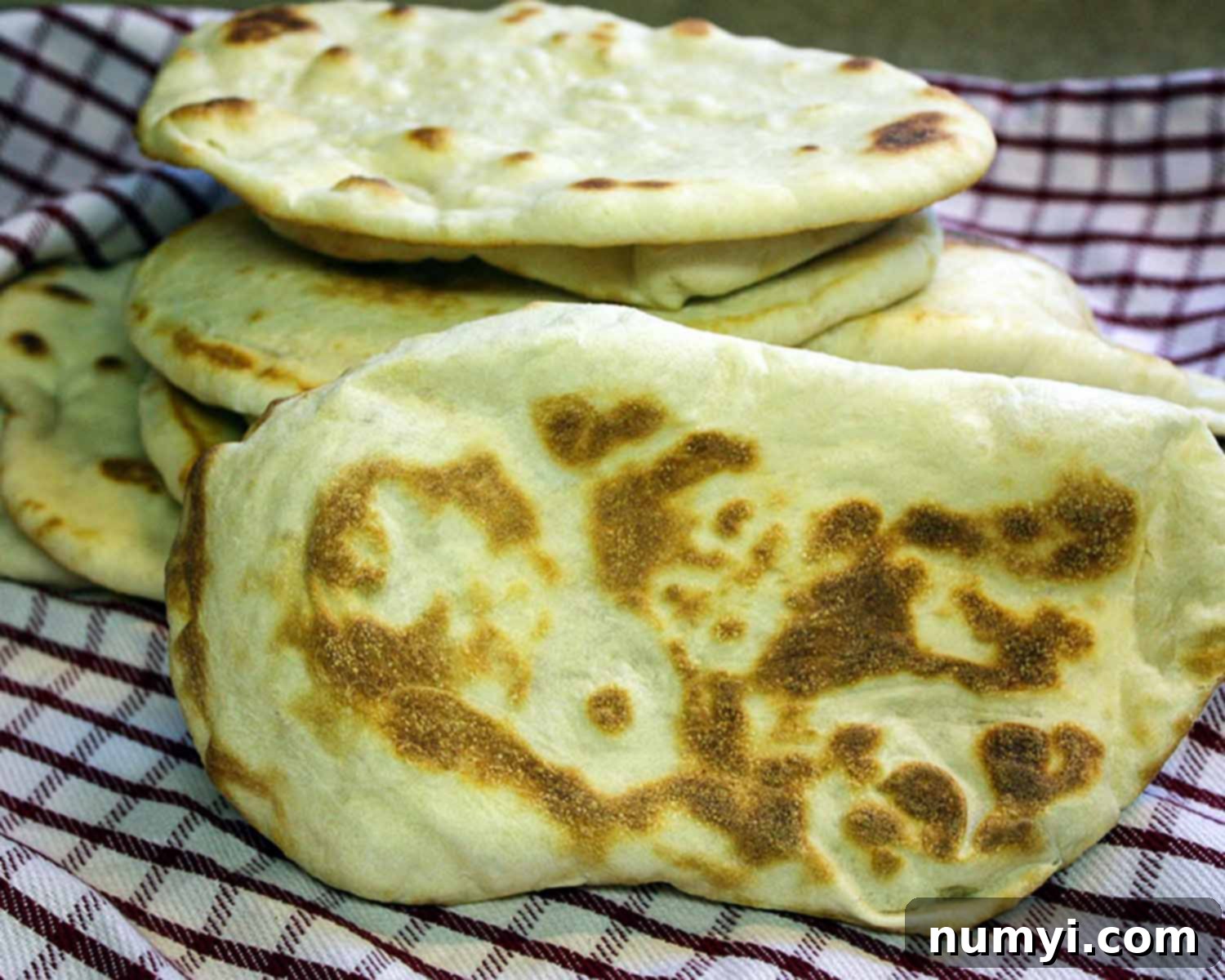Fluffy Homemade Naan Flatbread: An Easy Recipe for Authentic Indian Bread
Experience the unparalleled delight of freshly baked naan flatbread right in your own kitchen! This homemade naan recipe is surprisingly simple to master and yields incredibly soft, pillowy, and flavorful bread that far surpasses any store-bought alternative. Forget dry, stiff flatbreads; our method guarantees a tender, chewy texture perfect for soaking up delicious sauces or serving as a base for creative meals. We especially love using this versatile naan to complement our chicken gyros, transforming a simple meal into an extraordinary culinary experience. Get ready to impress your family and friends with this authentic and easy-to-follow recipe.
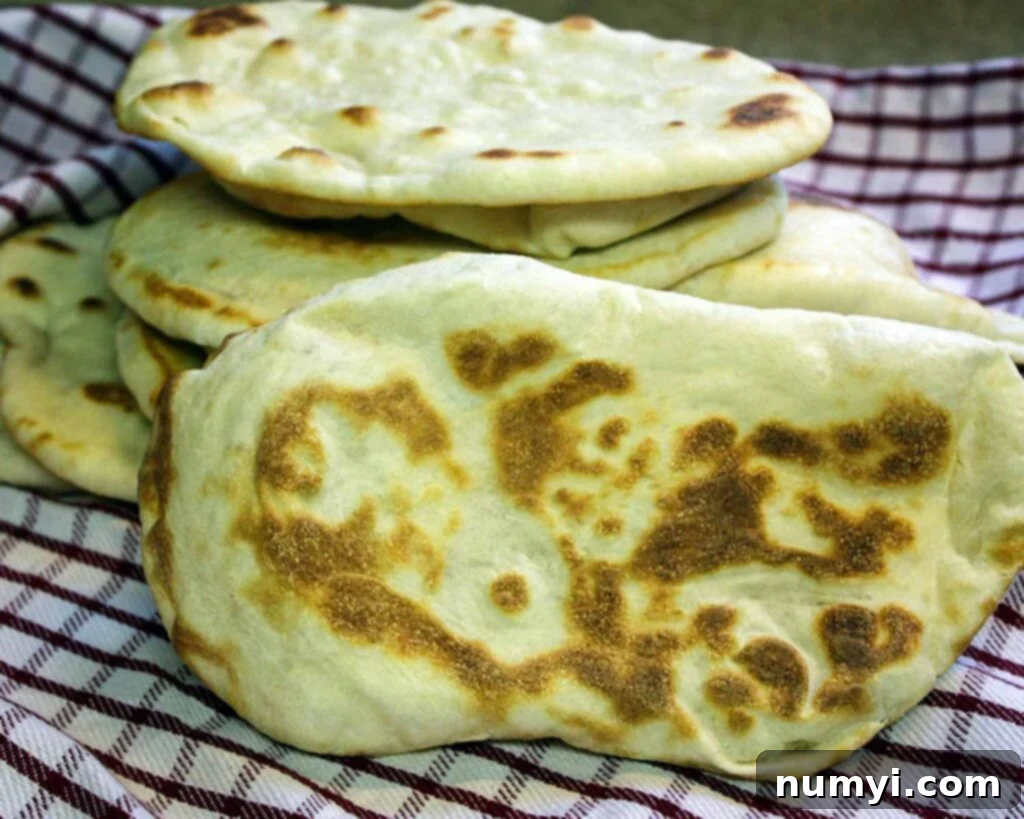
Don’t Sweat The Recipe is supported by its readers. We may earn a commission if you purchase through a link on our site. Learn more.
Why You’ll Adore This Homemade Naan Recipe
There’s truly nothing quite like the taste and aroma of freshly baked bread, and homemade naan is no exception. This recipe will quickly become a cherished staple in your kitchen for several compelling reasons:
- Unmatched Freshness and Flavor: Store-bought naan often lacks the vibrant flavor and tender texture of its homemade counterpart. With our recipe, you get warm, pillowy flatbreads bursting with a subtle, yeasty aroma and a delightful chewiness that’s simply irresistible. The difference in taste and texture is monumental, making every bite a culinary revelation.
- Surprisingly Simple to Make: Don’t let the idea of making bread from scratch intimidate you! This naan recipe is designed for ease, proving that incredible homemade bread doesn’t require advanced baking skills or a tandoor oven. With clear, step-by-step instructions, you’ll be amazed at how quickly you can achieve professional-quality results. You’ll wonder why you ever settled for pre-packaged naan.
- Incredibly Versatile: Naan is far more than just a side dish. It’s a culinary canvas! While it’s an absolute dream paired with rich curries like butter chicken or chicken tikka masala, its utility extends much further. Use it to scoop up flavorful dips like hummus or baba ghanoush, create quick and delicious naan pizzas, or wrap up your favorite fillings for gourmet sandwiches and gyros. Its soft texture makes it ideal for breakfast, lunch, or dinner.
- A Fun and Rewarding Baking Project: There’s immense satisfaction in creating something delicious with your own hands. Baking naan is an enjoyable process that fills your home with a wonderful aroma and rewards you with a truly special bread. It’s a fantastic activity for a weekend afternoon and a surefire way to elevate any meal.
If you enjoy baking bread, be sure to explore some of our other cherished bread recipes. These include hearty Sourdough Bread, delicate Puff Pastry Cheese Straws, incredibly Soft and Fluffy One Hour Dinner Rolls, and our flavorful Creole Cornbread. Each offers a unique and delicious accompaniment to any meal of the day, from a cozy breakfast to an elaborate dinner.
What Exactly is Naan?
Naan is a celebrated type of leavened flatbread, deeply rooted in the culinary traditions of India, Central Asia, and the Middle East. Characterized by its soft, chewy, and slightly elastic texture, naan is distinct from other flatbreads due to the use of yeast (or sometimes natural leavening) and its signature bubbly, slightly charred surface.
Traditionally, naan is baked in a tandoor oven – a cylindrical clay oven that reaches extremely high temperatures. The dough is slapped onto the hot walls of the tandoor, where it quickly cooks and puffs up, developing those desirable brown spots and a smoky flavor. While most home kitchens aren’t equipped with a tandoor, our recipe cleverly replicates this intense heat using a conventional oven and a pizza stone, achieving a remarkably similar authentic result. The high heat ensures a quick bake, trapping steam inside the dough to create that distinctively soft and airy interior.
More than just a side, naan is a fundamental component of many meals, acting as an edible utensil for scooping up curries, stews, and relishes. It’s an absolute staple in Indian restaurants worldwide, often served fresh from the oven, sometimes brushed with ghee or butter, and sprinkled with herbs like cilantro.
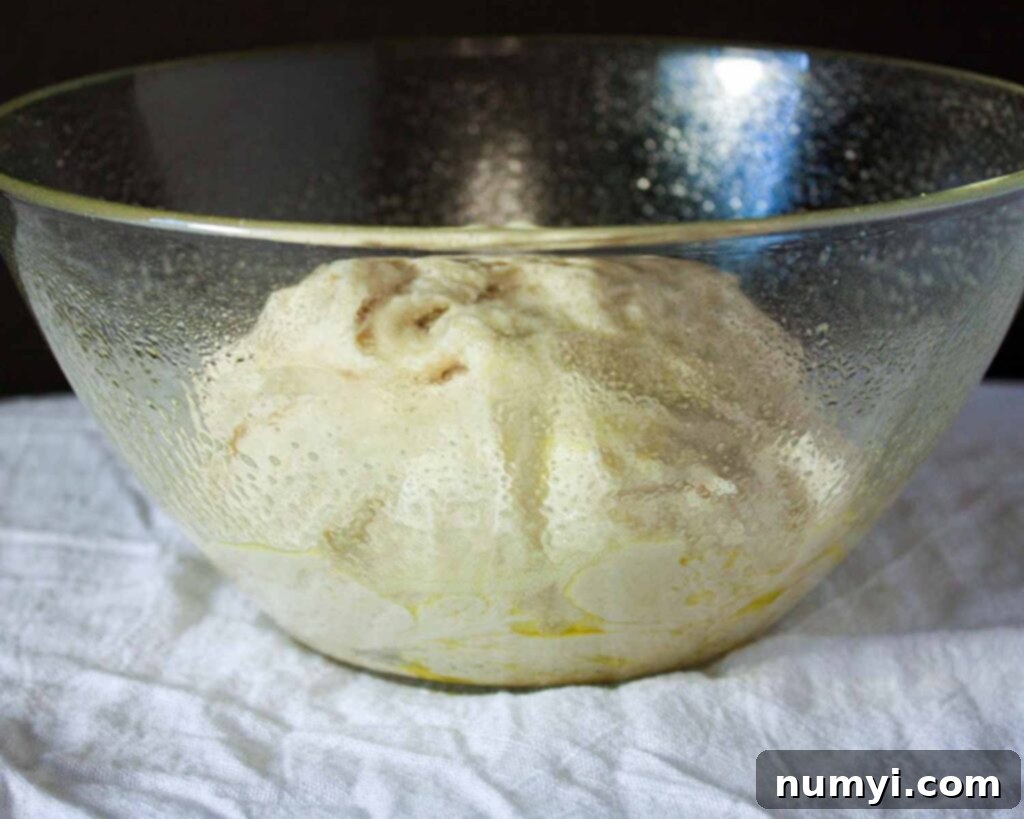
Essential Ingredients for Perfect Naan
Creating delicious homemade naan requires just a handful of common kitchen staples. Each ingredient plays a crucial role in achieving that signature soft, chewy, and flavorful flatbread. Here’s a breakdown of what you’ll need:
- All-purpose flour: This forms the base of our naan dough. While all-purpose flour works wonderfully, you can also use bread flour for an even softer and chewier texture, thanks to its higher protein content. Just be prepared to adjust the liquid slightly if using bread flour, as it may absorb more moisture.
- Active dry yeast or Instant yeast: Yeast is the magical leavening agent that makes our naan light and airy. Active dry yeast needs to be activated in warm milk with sugar, while instant yeast can often be mixed directly with the dry ingredients. Both will give you fantastic results; just follow the specific instructions for each in the recipe steps.
- Warm Milk: Instead of water, we opt for warm milk. The milk adds richness, a subtle sweetness, and contributes to the beautiful golden-brown crust. It also helps in tenderizing the dough, resulting in a softer crumb. The warmth of the milk is essential for activating the yeast; it should be around 105-115°F (40-46°C) – warm to the touch but not hot enough to kill the yeast.
- Granulated Sugar: A small amount of sugar acts as food for the yeast, helping it to activate and produce carbon dioxide, which creates those lovely bubbles in the naan. It also aids in browning the crust and adds a hint of sweetness to the finished bread.
- Salt: Essential for flavor balance and controlling yeast activity. Don’t skip it!
- Melted Unsalted Butter: Used both in the dough and for brushing on the cooked naan. Butter adds incredible flavor, richness, and keeps the naan soft and pliable.
You might notice that this recipe doesn’t call for yogurt, which is often found in other naan recipes. While yogurt can add tanginess, we’ve found that it can sometimes weigh down the naan, leading to a denser texture and a slightly gummy interior. Our combination of milk, sugar, and butter delivers a perfectly light, fluffy, and tender naan without any gumminess.
Crafting Your Naan Flatbread: A Step-by-Step Guide
Making naan from scratch is a rewarding process that’s much simpler than you might imagine. Follow these detailed steps to create perfectly soft and chewy naan every time. The key is to nurture your dough and allow it ample time to rise, building that beautiful, airy texture.
1. Activate the Yeast: The Foundation of Fluffy Naan
Begin by gently warming your milk. Pour 1 1/2 cups of milk into a microwave-safe measuring cup. Heat it in the microwave for approximately 30-45 seconds, or until it reaches a temperature of about 105-115°F (40-46°C). You can check this with an instant-read thermometer; it should feel comfortably warm to the touch, but not hot. Too hot will kill the yeast, too cold won’t activate it.
If using active dry yeast, stir in the 1 teaspoon of sugar and 1/2 teaspoon of yeast into the warm milk. Give it a gentle mix and let this mixture sit undisturbed for 4-5 minutes. During this time, the yeast will “proof” – you should see a foamy layer form on the surface, indicating the yeast is active and ready to work its magic. If no foam appears, your yeast might be old or the milk temperature was off, and it’s best to start again.
2. Combine Wet and Dry Ingredients
Once your yeast mixture is beautifully foamy, pour it into a large mixing bowl or the bowl of a stand mixer fitted with a dough hook. Add 1 teaspoon of salt and an initial 2 1/2 cups of all-purpose flour. If you are using instant yeast (which doesn’t require proofing), you can simply combine the warm milk, sugar, instant yeast, salt, and 2 1/2 cups of flour directly into the bowl at this stage.
3. Form and Knead the Dough
Begin mixing the ingredients on low speed (if using a stand mixer) or by hand with a sturdy spoon until everything is just combined. The dough will start to come together. Gradually add the remaining 1/2 to 1 1/2 cups of flour, a tablespoon at a time, until a soft, slightly sticky dough forms. The dough should gather cleanly from the sides of the bowl, but still feel supple. Avoid adding too much flour, as this can result in tough naan.
Now, it’s time for kneading. If using a stand mixer, knead on medium-low speed for 3-5 minutes until the dough is smooth, elastic, and no longer excessively sticky. If kneading by hand, turn the dough out onto a lightly floured surface and knead for about 8-10 minutes, pushing and folding until it achieves a similar smooth and elastic consistency. A well-kneaded dough is crucial for developing the gluten structure, which gives naan its characteristic chew.
4. First Rise: Allowing the Dough to Develop Flavor and Volume
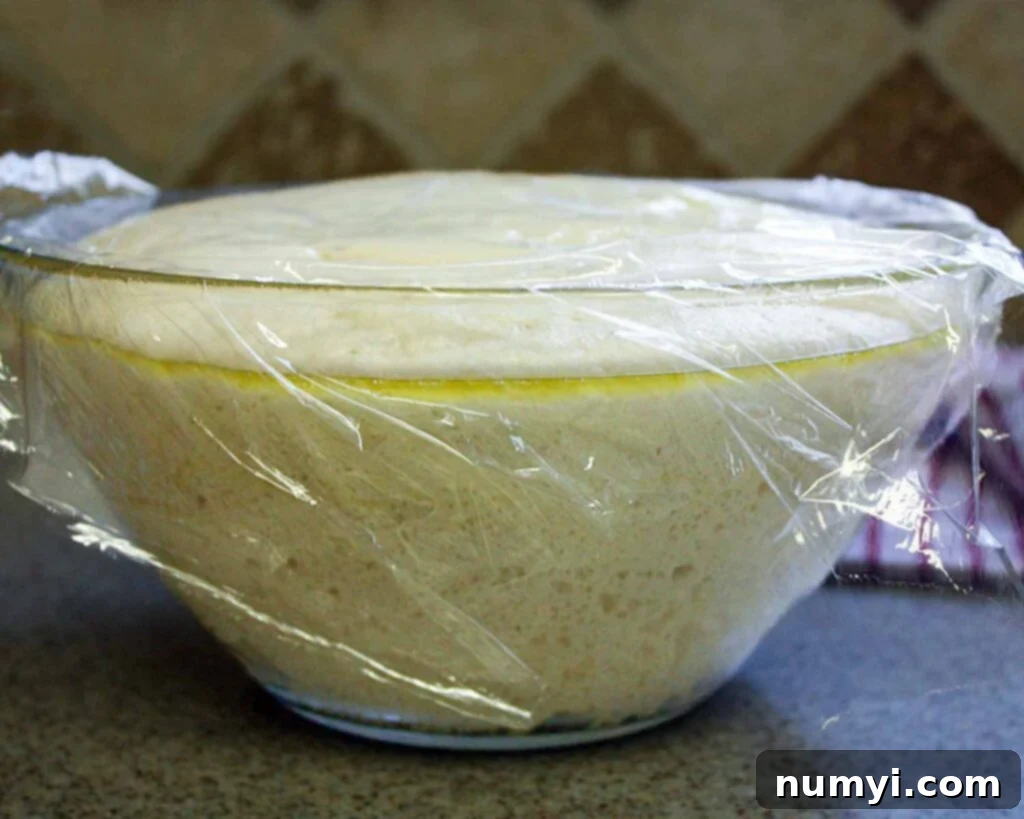
Lightly grease a large bowl with a little oil or cooking spray. Transfer the kneaded dough into this bowl, turning it once to coat all sides. Cover the bowl loosely with greased plastic wrap or a clean kitchen towel. Place it in a warm spot in your kitchen and let the dough rise at room temperature for approximately 1.5 to 2 hours, or until it has doubled significantly in volume. This first rise is critical for developing both flavor and texture in your naan.
Shaping Your Naan Dough: Crafting Perfect Portions
Once your dough has completed its glorious first rise and has doubled in size, it’s time to prepare it for baking. Gently turn the risen dough out onto a lightly floured countertop or a large wooden board. Avoid overworking the dough at this stage, as you want to preserve as much of that lovely airiness as possible.
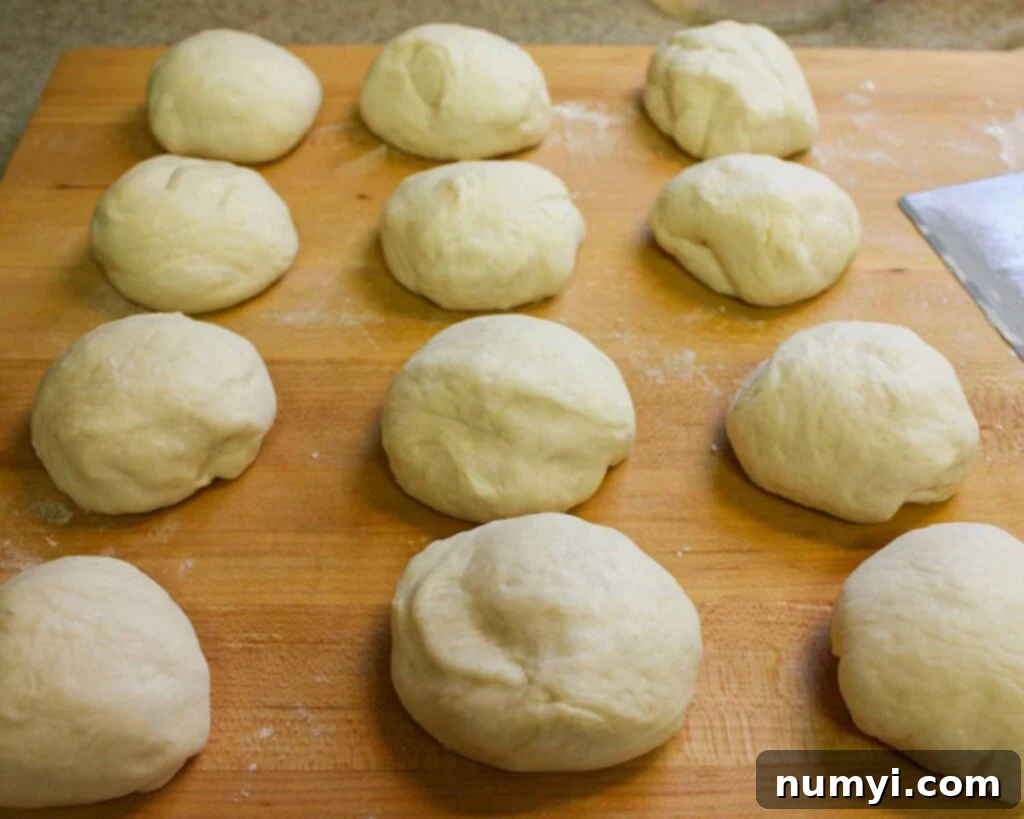
Using a bench scraper or a sharp knife, divide the dough into 12 equal pieces. For best results and uniform naan, you can weigh each piece to ensure they are roughly the same size. Gently round each piece into a smooth ball. This process creates tension on the surface of the dough, which helps it hold its shape and puff up beautifully during baking. Arrange the dough balls on your floured surface, then cover them with a clean kitchen towel. Allow these rounded portions to rest for an additional 30 minutes. This second, shorter rest is important as it allows the gluten to relax, making the dough easier to roll out and preventing it from springing back excessively.
Cooking Your Naan: Oven or Skillet Perfection
The cooking method is crucial for achieving the characteristic bubbly texture and slight char of authentic naan. While a traditional tandoor oven is ideal, we’ll guide you through using your home oven with a pizza stone, or a cast-iron skillet, for equally delicious results.
Using a Pizza Stone in the Oven (Recommended)
This method best mimics the high, dry heat of a tandoor. As your dough balls are completing their 30-minute rest, preheat your oven to a blazing 500°F (260°C). Crucially, place a pizza stone on the bottom rack of your oven during this preheating phase. It needs to get incredibly hot to properly cook the naan and create that satisfying puff. Allow at least 30-45 minutes for the stone to heat thoroughly after the oven reaches temperature.
Once the dough balls have rested, one by one, gently roll each piece into an oval or round shape, approximately 6 to 8 inches wide. The thickness is a matter of personal preference – roll it thinner for a crispier naan or leave it slightly thicker for a chewier texture. Try to work quickly to prevent the dough from drying out.

Carefully transfer a rolled-out dough circle onto the preheated pizza stone. For added moisture and to encourage puffing, lightly spritz the surface of the dough with water before closing the oven door. Bake for just 2-4 minutes. Keep a close eye on it! You’ll notice the naan beginning to puff up dramatically (some pieces more than others, which is perfectly normal) and beautiful brown spots will start to appear on the surface. These spots indicate perfect charring and flavor development.
Using tongs or a spatula, carefully remove the hot naan bread from the baking stone. Immediately transfer it to a wire cooling rack. While still warm, generously brush the top with melted unsalted butter – this adds a rich flavor and keeps the naan soft. As each naan comes out of the oven, stack them on top of each other and cover the stack with a clean kitchen towel. This traps the steam, keeping the naan soft and warm until ready to serve. You can serve the naan warm directly or allow it to cool completely for later enjoyment.
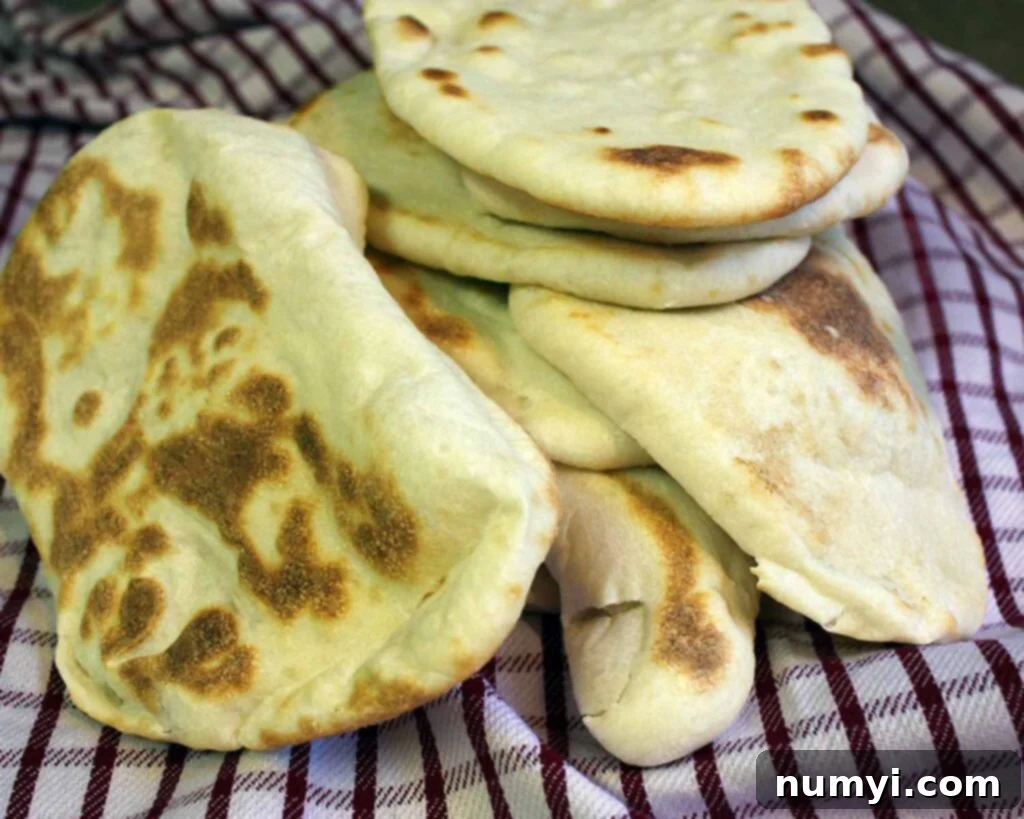
Expert Tips for Naan Perfection
Achieving restaurant-quality naan at home is simple with a few helpful pointers:
- Skillet Cooking Method: If you don’t have a pizza stone, or prefer a stovetop method, a heavy-bottomed pan or cast-iron skillet works beautifully. Heat your skillet over medium-high heat until it’s very hot but not smoking. Brush one side of your rolled-out dough with a little water (this helps create steam and puffiness). Place the wet side down onto the hot skillet. Cover the skillet with a lid and cook for 30 to 60 seconds, or until you see large bubbles forming on the surface. Remove the lid, flip the naan, and cook for another 10-20 seconds uncovered until it’s cooked through and has light brown spots. Immediately brush with melted butter. This method is quicker and still produces wonderful naan.
- Don’t Over-Flour: When kneading or rolling out the dough, use flour sparingly. Too much added flour can make the naan dry and tough. A lightly floured surface is all you need.
- Ensure Yeast is Active: Always check that your yeast proofs properly. If your milk-sugar-yeast mixture doesn’t get foamy after 5-7 minutes, your yeast may be dead, or the milk temperature was off. Start again with fresh yeast and properly warmed milk to avoid dense, flat naan.
- High Heat is Key: Whether using an oven with a pizza stone or a skillet, high heat is essential. This quick, intense heat causes the moisture in the dough to rapidly turn into steam, creating those characteristic bubbles and soft, airy pockets.
- Stack and Cover Cooked Naan: As each naan comes off the heat, stack them immediately and cover with a clean kitchen towel. This traps the steam, keeping the naan warm and incredibly soft and pliable, ready for serving.
- Experiment with Thickness: Adjust the thickness of your rolled-out naan to your preference. Thinner naan will be crispier, while thicker naan will be chewier and more bread-like.
- Make Naan Flatbread Pizzas: Naan makes an exceptional base for quick and delicious pizzas! Simply spread a thin layer of your favorite pizza sauce or pesto, add your desired toppings, and bake until the cheese is melted and bubbly. This is a fantastic way to utilize leftover naan or enjoy a fast weeknight meal.
Transform Your Naan into Delicious Pizzas
One of the most delightful ways to enjoy homemade naan is by turning it into a quick and customizable flatbread pizza! The soft, chewy texture of naan makes an excellent base. Simply:
- Spread a thin, even layer of your favorite pizza sauce, marinara, or even a flavorful pesto.
- Sprinkle generously with your choice of shredded or fresh mozzarella cheese.
- Add an array of your preferred toppings. The possibilities are endless, but here are some popular ideas:
- Cooked ground sausage or spicy Italian sausage
- Classic pepperoni slices
- Sliced fresh mushrooms or sautéed onions
- Colorful bell peppers (diced or thinly sliced)
- Sweet cherry tomatoes, halved
- Crumbled feta cheese for a Mediterranean twist
- Fresh basil leaves after baking for an aromatic finish
- Grilled chicken or leftover shredded chicken
- Bake in a preheated oven (around 400°F / 200°C) for 8-12 minutes, or until the cheese is melted and bubbly and the crust is lightly golden.
Naan pizzas are perfect for a quick lunch, an easy dinner, or a fun party appetizer!
Flavorful Naan Variations to Explore
While plain naan is delicious on its own, it’s also incredibly versatile and can be easily customized with various additions before or after cooking. Here are some popular variations to elevate your homemade naan:
- Garlic Naan: This is a fan favorite! After brushing your cooked naan with melted butter, sprinkle generously with freshly minced garlic or garlic powder. Alternatively, create a garlic butter by mixing 2-3 tablespoons of melted butter with 1-2 cloves of minced garlic and a pinch of salt, then brush this mixture on the hot naan.
- Herb Naan: Before baking, gently press finely chopped fresh cilantro or parsley onto the surface of the rolled-out dough. You can also brush the cooked naan with an herb-infused oil.
- Cheese Naan: For a delightful cheesy surprise, sprinkle a small amount of shredded mozzarella, cheddar, or crumbled paneer (Indian cheese) onto one half of the rolled-out dough, then fold the other half over and seal the edges before cooking. Or simply sprinkle cheese on top before baking.
- Sesame Naan: For a nutty flavor and appealing texture, sprinkle sesame seeds (white or black) onto the rolled-out dough before placing it on the hot pizza stone or skillet.
- Kalonji (Nigella) Seeds: These small black seeds, often used in Indian cuisine, add a unique onion-like flavor and visual appeal. Sprinkle them onto the dough before baking.
- Cumin Seeds: A sprinkle of cumin seeds over the dough before cooking imparts a warm, earthy aroma and taste.
- Spicy Naan: Add a pinch of red chili flakes or finely minced green chilies to your dough or sprinkle them on top before baking for a touch of heat.
- Garlic Oil Brush: Instead of butter, brush your hot, cooked naan with a fragrant garlic oil. To make, combine 2-3 tablespoons of good quality olive oil with 2 cloves of freshly minced garlic and a tiny pinch of salt. This gives a lighter, yet still flavorful, finish.
Feel free to mix and match these variations to create your signature naan!
Frequently Asked Questions About Homemade Naan
Naan is incredibly versatile and pairs wonderfully with a wide array of dishes. It’s traditionally served with Indian curries like rich and creamy Butter Chicken, flavorful Chicken Tikka Masala, or various lentil (dal) dishes. Beyond Indian cuisine, it makes an excellent accompaniment to Mediterranean dishes like Chicken Gyros, or with savory stews and kebabs. It’s also perfect for scooping up dips such as hummus, baba ghanoush, or a simple garlic yogurt dip, making it a fantastic appetizer. Don’t forget its potential as a base for quick pizzas or gourmet sandwiches!
Absolutely! You can prepare the naan dough up to 24 hours before you plan to cook it. Follow the recipe instructions through the first rising step (Step 5). After the dough has completed its initial rise, punch it down gently to release the air, then place the covered bowl in the refrigerator. When you’re ready to bake, remove the dough from the fridge at least 2-3 hours beforehand. This allows the dough to come to room temperature and for the chill to wear off, which is crucial for the second rise and optimal texture. Once it’s no longer cold, proceed by dividing it into balls and continuing with the recipe from Step 6 onwards.
Yes, freezing uncooked naan dough is a great way to have fresh naan on demand. Prepare the dough up to the point of forming the individual dough balls (Step 6), but do not let them undergo the 30-minute rest. Instead, arrange the dough balls on a parchment-lined baking sheet, ensuring they are about 2 inches apart to prevent sticking. Flash freeze them for approximately 2 hours, or until they are solid. Once frozen, transfer the solid dough balls to a freezer-safe container or a heavy-duty freezer bag, and store for up to 3 months. When you’re ready to bake, simply place the desired number of frozen dough balls on a new parchment paper-lined baking sheet, cover them loosely with plastic wrap, and let them thaw and rise at room temperature for about 4-5 hours (or longer if your kitchen is cool). The dough should visibly increase in size. After thawing and rising, you can proceed with the cooking process as directed in the recipe, starting from rolling out the dough.
Cooked naan is best enjoyed fresh, but leftovers can be stored. Place cooled naan in an airtight zip-top bag or container and store in the refrigerator for 3-5 days. To reheat, lightly wrap individual pieces in a damp paper towel and microwave for 20-30 seconds, or until warm and soft. You can also reheat them quickly in a hot dry skillet or warm oven until pliable.
Yes, cooked naan freezes well! To prevent sticking, allow the naan to cool completely, then stack individual pieces with parchment paper in between. Place the stack in a freezer-safe bag or airtight container and freeze for up to two months. When ready to use, simply thaw at room temperature and reheat using the methods mentioned above (microwave with damp paper towel, skillet, or oven).
More Delicious Bread Recipes
Easy No Knead Overnight Focaccia Bread
Easy Homemade Crescent Rolls
Italian Bread Recipe
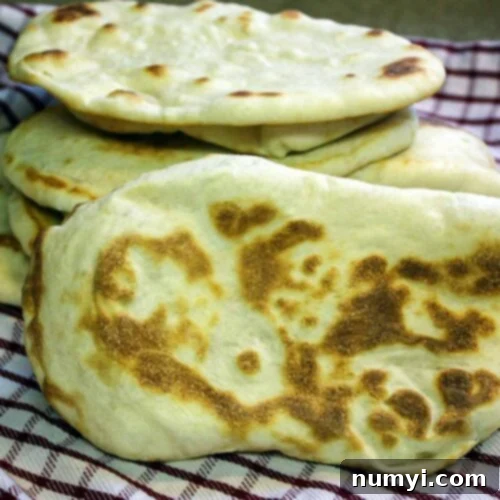
Naan Flatbread Recipe
Print
Pin
Rate
Ingredients
- 3-4 cups All-purpose flour
- 1 tsp. Salt
- 1/2 tsp. Active dry or instant yeast
- 1 1/2 cups Milk
- 1 tsp Sugar
- 3-4 Tbsp. Unsalted butter melted
Instructions
-
Pour the milk into a liquid measuring cup and heat in the microwave until it is warm to the touch, ideally between 105-115°F (40-46°C). Using an instant-read thermometer will give the most accurate reading. If using active dry yeast, stir in the sugar and yeast into this warm milk. Allow the mixture to sit undisturbed for 4-5 minutes until a foamy layer forms on top, indicating the yeast is active. If no foam appears, your yeast may not be viable, and it’s best to start over.1/2 tsp. Active dry or instant yeast, 1 1/2 cups Milk, 1 tsp Sugar
-
Once the yeast/milk mixture is actively foamy, pour it into a large mixing bowl or the bowl of your stand mixer. Add the salt and 2 1/2 cups of the all-purpose flour. If you are using instant yeast, simply pour the warm milk into your mixing bowl, then add the sugar, instant yeast, salt, and the initial 2 1/2 cups of flour. Proceed to the next step directly.3-4 cups All-purpose flour, 1 tsp. Salt
-
Begin mixing the ingredients thoroughly to combine. Gradually add the remaining all-purpose flour, a small amount at a time (about 1/4 cup increments), until a soft, slightly tacky dough forms. The dough should pull away from the sides of the bowl cleanly, but still feel quite soft and pliable. Be careful not to add too much flour, as this will make your naan tough.
-
Knead the dough until it is smooth and elastic. If using a stand mixer with a dough hook, this will take about 3-5 minutes on medium-low speed. If kneading by hand, turn the dough onto a lightly floured surface and knead for approximately 8-10 minutes, pushing and folding the dough until it develops a smooth, resilient texture. Proper kneading is vital for developing the gluten structure.
-
Lightly grease a large bowl with oil or cooking spray. Transfer the kneaded dough to this bowl, turning it once to ensure all sides are coated. Cover the bowl loosely with plastic wrap that has also been lightly greased, or use a clean, damp kitchen towel. Allow the dough to rise at room temperature for about 1.5 to 2 hours, or until it has noticeably doubled in volume. This extended rise develops the rich flavor and airy texture.
-
After the first rise, gently turn the dough out onto a lightly floured surface. Using a bench scraper or knife, divide the dough into 12 equal pieces. For best consistency, you might weigh them. Roll each piece into a neat ball shape, creating surface tension. Arrange the dough balls on your floured surface, cover them with a clean kitchen towel, and let them rest for an additional 30 minutes. This short rest helps the gluten relax, making the dough easier to roll out.
-
While your dough balls are resting, preheat your oven to a high temperature of 500°F (260°C). Crucially, place your pizza stone on the bottom rack of the oven as it preheats. The stone needs ample time (at least 30-45 minutes after the oven reaches temperature) to get thoroughly hot, which is essential for proper naan cooking and puffing.
-
Once the dough balls have rested for 30 minutes, working one at a time, use a rolling pin to roll each piece into an oval or circular shape, approximately 6-8 inches wide. You can adjust the thickness based on your preference – thinner for crispier, thicker for chewier. Carefully lay the rolled dough circle directly onto the preheated pizza stone. For maximum puff, lightly spritz the surface of the dough with water before closing the oven door.
-
Close the oven door and bake the naan for a short period, typically 2-4 minutes. Watch closely as it cooks; the naan will begin to puff up dramatically, forming large bubbles, and beautiful brown spots will appear on its surface. This indicates it’s cooked through and has developed its signature flavor and texture.
-
Using tongs or a spatula, carefully remove the hot naan from the baking stone and transfer it to a wire cooling rack. Immediately, generously brush the top surface with melted unsalted butter. This adds a wonderful richness and helps keep the naan soft. As each naan comes out of the oven, stack them directly on top of each other.3-4 Tbsp. Unsalted butter
-
Once all the naan are cooked and buttered, cover the entire stack with a clean kitchen towel. This clever trick traps the steam, ensuring your naan remains incredibly soft, pliable, and warm until you’re ready to serve. Enjoy your homemade naan fresh and warm, or let it cool completely for later.
Notes
Storage – To keep cooked naan fresh, allow it to cool completely before placing it in an airtight zip-top bag or container. It can be stored in the refrigerator for 3-5 days. For longer storage, freeze cooked naan by layering individual pieces between sheets of parchment paper in a freezer-safe bag or container for up to 2 months. Reheat refrigerated naan by wrapping it in a damp paper towel and microwaving for 20-30 seconds, or warm it in a hot skillet or oven. Frozen naan can be thawed at room temperature and then reheated.
Nutrition
Recipe from chef-in-training
